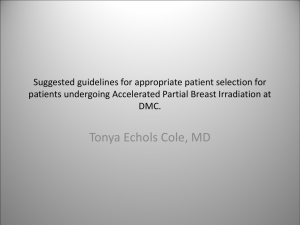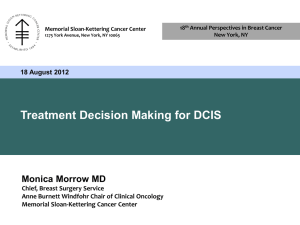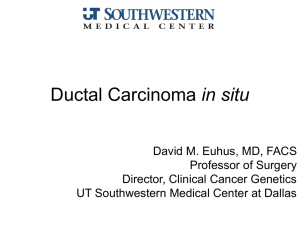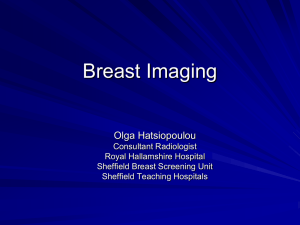04.Ductal Carcinoma In Situ
advertisement
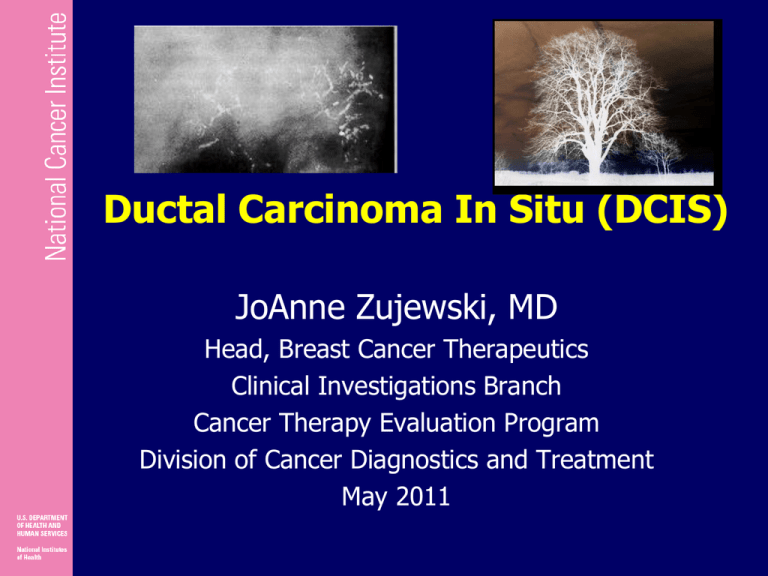
Ductal Carcinoma In Situ (DCIS) JoAnne Zujewski, MD Head, Breast Cancer Therapeutics Clinical Investigations Branch Cancer Therapy Evaluation Program Division of Cancer Diagnostics and Treatment May 2011 Questions • How DCIS differs from Stage 1 breast cancer • Types of DCIS that affect prognosis of DCIS/development of breast cancer • Standard of Care: surgery, radiation risks of under-treatment and overtreatment • Can we improve diagnosis through MRI and sentinel lymph node biopsy? Pathobiologic Events Associated with DCIS Burstein H et al. N Engl J Med 2004;350:1430-1441 DCIS: Pathology Comedo Rosen’s Breast Pathology, 1997 Solid, Low grade Cribiform, High grade DCIS: actin Stain of Myoepithelium Rosen’s Breast Pathology, 1997 SEER Breast Carcinoma in situ 5-year Survival : 1992-1999 All < 50 50+ All 100.0 99.9 100.0 White 100.0 100.0 100.0 Black 100.0 99.5 100.0 Survival DCIS: RCT N Mets NSABP B17 EORTC 813 1002 UKANZ NSABP B24 CTG 1694 1798 17 24 (2.1%) (2.4%) Breast 27 15 23 Deaths (3.3%) (1.5%) (1.4%) Years 10.8 4.3 4.4 F/up 11 (0.6%) 15 (0.8%) 6.9 Natural History • 25 cases untreated with 16 yrs follow up – 28% developed invasive cancer – 11 fold increase in relative risk to controls • Contralateral relative risk 2-3 Page et al Cancer 1985;55:2698-708 Role of Total Mastectomy Year No. cases % mortality Ashikari 1971 182 0.9 Rosner 1980 182 2.0 Farrow 1970 181 2.0 Silverstein 1996 228 0 Bradley 1990 588 1.7 Surgery • Mastectomy has not been compared to BCT in randomized trials of DCIS • Breast cancer deaths within 10 years after the diagnosis of DCIS occurs in 12% of all patients, irrespective of surgery type RATIONALE FOR RADIATION TREATMENT AFTER LUMPECTOMY FOR DCIS • All reported randomized trials show that radiation reduces the rate of local recurrence after lumpectomy by about half • “[P]atients who may avoid radiation therapy have not been reproducibly and reliably identified by any clinical trials.” (1999 DCIS Consensus Conference Statement, Cancer, 2000) Slide courtesy of L. Solin Oxford Overview of Randomized Trials of BCS±RT for DCIS DCIS: BCS + RT vs. BCS Ips. BREAST RECURRENCE (CIS & Inv) 5-year gain 10.5 % (SE 1.2) 10-year gain 15.2 % (SE 1.6) logrank 2p < 0.001 50 40 30 18.1 20 10 60 5-year gain 5.4 % (SE 0.8) 10-year gain 8.5 % (SE 1.3) logrank 2p < 0.001 50 40 BCS 28.1% 30 20 BCS+RT 12.9% 8.5 10 3723 women 5-year gain 5.8 % (SE 0.9) 10-year gain 8.4 % (SE 1.2) logrank 2p < 0.001 50 40 30 20 BCS 15.4% BCS 14.9% 10.5 10 BCS+RT 6.8% 7.6 0 0 0 DCIS: BCS + RT vs. BCS Ips. BREAST RECURRENCE (CIS only) 3723 women Ips. BREAST RECURRENCE (CIS only) (%) 60 3723 women Ips. BREAST RECURRENCE (Inv only) (%) 60 DCIS: BCS + RT vs. BCS Ips. BREAST RECURRENCE (Inv only) 5 10 Years since randomisation 15 17:41:28 9 Sep 2009 Provisional results: subject to revision (Name: gr_cis_sc_rt_rlili_all_0) 0 BCS+RT 6.5% 4.7 0 3.1 5 10 Years since randomisation 15 17:42:03 9 Sep 2009 Provisional results: subject to revision (Name: gr_cis_sc_rt_rlilii_all_0) 0 5 10 Years since randomisation 15 17:42:38 9 Sep 2009 Provisional results: subject to revision (Name: gr_cis_sc_rt_rllic_all_0) Presented NIH DCIS Conference, 2009 Darby, JNCI Monograph, 2010 ECOG STUDY E5194 (n = 670) Registration of small DCIS after wide excision alone Negative margin width > 3 mm Tamoxifen optional Two arms (not randomized) Grade 1-2, non-comedo, size < 2.5 cm Grade 3, comedo, size < 1.0 cm Low/intermediate grade Tumor size (median) 6 mm Negative margin width >5mm >10mm Hughes, JCO, 2009 69.2% 48.5% High grade 5 mm 82.9% 53.3% ECOG E5194: EXCISION WITHOUT RADIATION (+/-TAM) 0.15 15% 0.05 High grade Low or intermediate grade Ipsilateral (43 events/ 572 cases) Contralateral (18 events/ 572 cases) 6% 0.0 4% 0 2 4 6 8 Year Hughes, JCO, 2009 LOCAL FAILURE ACCORDING TO PATHOLOGY Lumpectomy plus radiation Lumpectomy alone Solin, JCO, 1996 Slide courtesy of L. Solin Balleine, Clin Cancer Res, 2008 DCIS: NSABP B-24 Role of Tamoxifen Fisher, B, Lancet 353:1993-2000, 1999 DCIS: NSABP B-24 Median follow-up 7 years placebo tamoxifen Pvalue All breast cancer 145 16% 84 9.3% ipsilateral 100 11.1% 72 7.7% 0.02 Contralateral 45 4.9% 25 2.3% 0.01 survival 95% 95% Fisher, B et al, Semin Oncol 28:400-18, 2001 NSABP B-24: Conclusions • Tamoxifen decreases risk of breast cancer events by 40% • No difference in overall survival The Risk of Ipsilateral or Contralateral Breast Tumor for Patients with DCIS Treated with Excision Alone; Excision and Radiotherapy; Excision, Radiotherapy, and Tamoxifen; or Excision, Radiotherapy, and Placebo Burstein H et al. N Engl J Med 2004;350:1430-1441 DCIS: Conclusions • Local therapy – Mastectomy – Breast Conserving Surgery plus radiotherapy • Consider omission if – Short lifespan – Sever co-morbidities • Systemic therapy: Tamoxifen – “Prevention” intervention – Consider individual risk/benefits What about lymph nodes? • Axillary lymph node involvement is <1% therefore axillary lymph node dissection is not recommended • Sentinel lymph node biopsy? – Not recommended due to low risk of disease unless performing a mastectomy (in the chance that invasive disease is found) – Consider: extensive high grade DCIS or palpable mass (increased chance of invasive disease being found) Potential Benefits • SLNB at time of definitive surgery avoids 2nd operation in 2-21 % of patients who have IDC at definitive surgery • May identify subset of patients who would benefit from systemic therapy Risks of SLNB in DCIS • Increase anxiety: curable prognosis to one that is life-threatening • SLNB risks – infection, bleeding, seroma, paresthesias, anaphylaxis, lymphedema (3%) • Risks of full ALND in up to 13% • Risks of systemic chemotherapy ? • Public health costs Mammography is the current standard for detection of DCIS, MRI could help improve the ability to diagnose DCIS, especially in high-grade DCIS DCIS: Calcifications Cannot be diagnosed as non-invasive with cytology Irregular clusters Branching (comedo) MRI: Contrast required…..spatial resolution improves morphologic assessment Mass, heterogeneous and rim enhancement, spiculated margins DCIS consensus conference. C. Lehman DCIS diagnosed in high risk patient on screening MRI with negative screening mammogram Fine linear, branching NMLE in ductal distribution DCIS consensus conference. C. Lehman ACR-ASS-CAP-SSO 2006 practice guideline • The role of other image modalities, especially MRI, has yet to be established in DCIS. • Berg found that MRI was more sensitive than mammography and sonography in detecting DCIS; however, disease extent was overestimated in 50% of involved breasts. • The impact of MRI on clinical outcomes such as local recurrence in the preserved breast remains to be demonstrated. KEY QUESTIONS FOR THE MANAGEMENT OF DCIS Answers 1. Is there a subgroup of patients for which the risk of local recurrence is low enough that the risk/benefit ratio warrants omission of radiation? Probably 2. If so, can one identify reproducibly and prospectively that subgroup of patients for treatment with excision alone (without radiation)? No 3. After lumpectomy, should (almost) all patients receive maximal treatment to reduce the risk of local recurrence? - Radiation - Tamoxifen, if ER/PR positive Yes Yes Courtesy of L. Solin 2010

